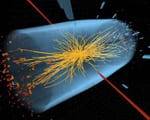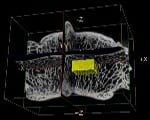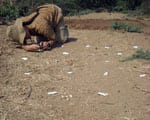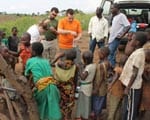Can a manufacturing industry purr along without a class system of managers and workers? That’s part of a longtime mystery that may soon be solved: How did a prehistoric, egalitarian people called the Hohokam produce large quantities of decorated ceramic vessels without a “manager” hierarchy?
Archaeologists from Southern Methodist University in Dallas and the Cultural Resource Management Program of the Gila River Indian Community in Arizona have launched a unique research partnership to solve the puzzling mechanics of the large-scale industry.
The vessels were made in about 1000 A.D. by a culture archaeologists call the Hohokam. The ancient people used the pottery for daily serving, storage, and social and religious gatherings. Today’s Gila River residents, the O’odham, are descendants of the Hohokam.





The National Science Foundation is funding the research with a $134,636 grant.
Unprecedented partnership
Under the landmark research partnership, the tribe and SMU hope to decipher the mechanics of the Hohokam ceramic technology and manufacturing techniques.
The three-year project examines artifacts and ceramic production materials from 12 sites in the Sonoran Desert just south of what is now Phoenix, according to archaeologists and co-investigators Sunday Eiselt and J. Andrew Darling. Eiselt is director of the SMU-in-Taos Archaeological Field School and an SMU assistant professor in the SMU Department of Anthropology. Darling is director of the O’odham tribe’s Cultural Resource Management Program.
The analysis looks at a slice of time from 1000 A.D. to 1070 A.D. when production of the decorated ceramic pots, known as “red-on-buff,” was at its peak, said Eiselt and Darling.
Ritually regulated or a managerial elite?
The researchers will probe how a prehistoric society that was fairly egalitarian, without cities or strict social classes, was able to mass-produce ceramic pottery, Eiselt said.
The pottery was critical to a complex system of water management devised by the Hohokam. They used hand-dug canals to irrigate thousands of miles of desert, making the land suitable for growing a wide variety of farm crops.
As pottery specialists living along the middle Gila River, the Hohokam produced and perhaps traded thousands of vessels to the entire region in return for agricultural commodities from surrounding groups, according to the researchers.
“With production output at the level suggested by the millions of sherds and vessel fragments recovered from archaeological sites of this period, we would expect to find political hierarchies, craft specialists, guilds and mass-production techniques,” Eiselt said. “In this situation that wasn’t the case. The results have the potential to show that highly productive craft industries can occur in the absence of managerial elites.”
Hierarchical forms of management for mass-production are more familiar in the non-Indian world, Darling said.
“It’s been postulated by archaeologists that stratification and ranking can be superceded by alternative approaches to production in quantity,” Darling said. “That’s particularly true for societies whose traditional beliefs are not ruled by the bottom line or production and demand.”
Which theory is right?
Eiselt and Darling said the current study will test two competing hypotheses by probing the organizational principles and capacity of core Hohokam technological systems:
- The first proposes that a number of villages were producing ceramics independently and trading them for agricultural products — such as cotton — to outside consumers.
- The second proposes that ceramic manufacturing was highly concentrated in one or a few villages that were supplied with raw materials by other villages. That implies a greater level of inter-village coordination to create greater economies of scale at the expense of emerging settlement hierarchies.
“The competing hypotheses will be tested through geochemical and petrographic examination of raw materials and ceramic artifacts in order to determine how the Hohokam achieved such great economic and production success,” Eiselt said.
Petrographic thin-section analysis and chemical assays will target the components of red-on-buff sherds — including clay, temper and paint — to identify and characterize raw material sources and reconstruct patterns of ceramic manufacture, the researchers said.
The mineralogical and chemical composition of raw material from different geographical sources will be compared to ceramics from sites across the region.
“This will enable us to map the circulation of raw materials, not just finished products, and thereby identify, geochemically, not only resource trade, but the segmentation of tasks among producer communities, in so far as that existed,” Eiselt said.
From there the researchers can test whether ceramic manufacture for exchange was concentrated at independent centers, or whether there was a division of labor in the production and distribution of raw materials that was part of a broader system for enhancing production efficiency. It will also show whether or how the productive system connected with regional exchange or nascent market systems.
Building on existing Gila research
The project is part of the community’s efforts to recover information from archaeological sites impacted by centuries of development, said Darling. Work will take place on the Gila River Indian Community Reservation under the oversight of the Cultural Resource Management Program.
Results will aid the Pima-Maricopa Irrigation Project, an ongoing effort to restore water resources that were historically lost to the O’odham — previously called Pima — through diversion and damming, Darling said.
The research project builds on earlier fieldwork conducted by the Gila River’s tribal archaeology program. The tribe, in turn, hopes to benefit from SMU’s archaeological expertise, Darling said.
“This is building the tribe’s capacity to conduct scientific research on its own,” he said. “Through collaborative research projects with SMU the tribe is able to exercise its sovereignty in the areas of intellectual research and academic development — not just to inform the world, but to restore the past to the community for their benefit and for future generations at Gila River.”
Both entities benefit, Eiselt said.
“The Gila River Indian Community is investigating the past within the confines of its community with its own team of cultural resource specialists and highly trained archaeologists,” Eiselt said. “It is a rare privilege for SMU to collaborate.” — Margaret Allen

 Academic achievement improved among students active in structured after-school programs
Academic achievement improved among students active in structured after-school programs















 Human diabetes has new research tool: Overfed fruit flies that develop insulin resistance
Human diabetes has new research tool: Overfed fruit flies that develop insulin resistance
 SMU to help solve dangerous refugee water issues
SMU to help solve dangerous refugee water issues



 Ancient tree-ring records from southwest U.S. suggest today’s megafires are truly unusual
Ancient tree-ring records from southwest U.S. suggest today’s megafires are truly unusual
 New study on kingship and sainthood in Islam offers a striking new historical perspective
New study on kingship and sainthood in Islam offers a striking new historical perspective Middle school boys who are reluctant readers value reading more after using e-readers
Middle school boys who are reluctant readers value reading more after using e-readers CERN scientists find hints of Higgs boson — “God” particle
CERN scientists find hints of Higgs boson — “God” particle
